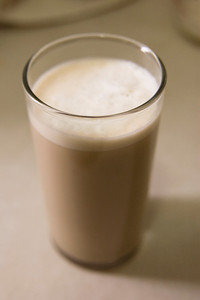
If you have traveled to Spain (or some parts of South America), you may have been lucky enough to experience cafe con leche (literally “coffee with milk”), which is a staple of breakfasts all over Iberia. Cafe con leche is strong coffee mixed with warm or scalded milk. While it’s often compared to Italian cappuccino, it doesn’t have the acid bite or bitterness that most American coffee drinks feature. It’s still got that caffeine jolt, but it’s a far more pleasurably mellow experience than either coffee or cappuccino.
It is the low-acidity part of the cafe con leche that makes it so difficult to recreate at home, as nearly all commercially available coffees are strongly acidic when brewed. Most Spanish coffee beans are made using a Torrefacto process of roasting, which involves introducing sugar to the beans during the roasting process, making them less acidic (and also much higher in antioxidants), but it’s difficult to find torrefacto beans domestically. Adding to the challenge, cafe con leche should be made with strong coffee, usually espresso, which heightens the flavor of the beans.
To capture the real flavor of cafe con leche at home, the secret is to start with cold press coffee. Cold brewing means you use time instead of heat to extract the coffee flavor into the water. The result is a very low-acid but strong coffee that can be stored in the refrigerator for future use.
Cold Press Coffee
1 lb. ground coffee (medium or strong roast)
12 c. cold water
Soak coffee in water for 12 hours at room temperature, then strain out grounds. Cold press coffee at this stage is strong, and can be mixed with water or milk for iced coffee or hot water for coffee.
Cafe con Leche (serves 2)
Warm 1 cup of cold press coffee on stove top till hot but do not boil. Place in cup.
Put 1 cup of milk (preferably whole milk) on stove top and stir constantly until warm and almost boiling. (If you have a cappuccino maker or steam wand, use that instead).
Milk equal parts coffee and milk together and serve immediately. Add sugar if desired.

I guess I have to ask – if they both start cold and both go until almost boiling, is there any reason to not combine these in the same pot on the stove? Is there some curdle-preventing magic that you get by heating separately and combining when hot? Or is it just so you can use a steam wand on the milk? Having no such wand, I’d probably throw them together in the same pot.
Silly as it sounds, I had actually not thought about combining them while heating. Some combination of having a steam wand and usually heating the coffee for some other reason anyway made me not try to heat them together. Someone else might speak to the possible curdle issue, but let me know if it works out!
A steam wand is used for more than simply heating the water. When done properly it actually sweetens the milk, which is why in a great cafe your milk based drinks will taste naturally sweet. So if you have a steam wand and you want it sweeter, steam it. Otherwise heating it on the stove you will have to add sugar if you want a sweeter cup.
for what it is worth, my grandma used to combine them on the stove while heating (on a clay vessel). Oh, and this is staple in mexico as well. No need to go that far, or is it more romantic that way?
Anywhere in the Cities (or beyond) who actually serve an authentic cafe con leche?